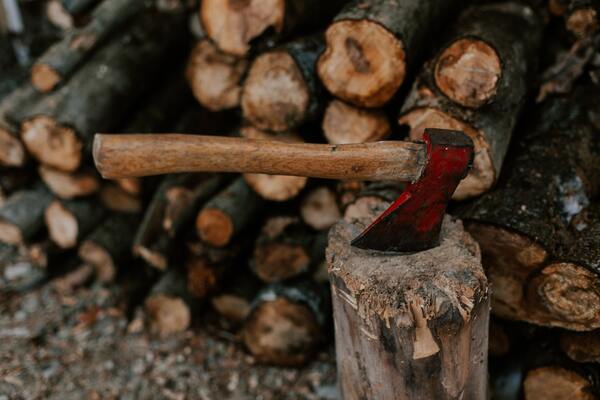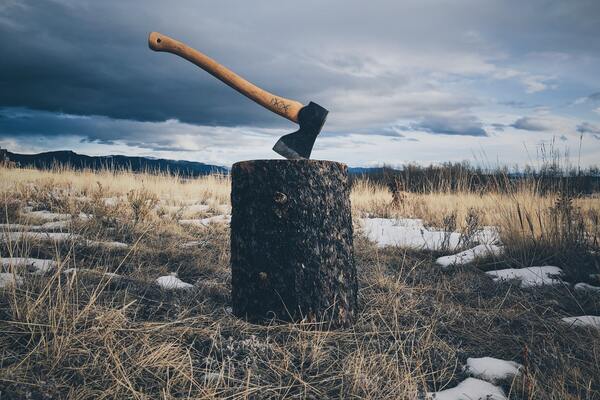An axe user’s most frequent issue is rust on the axe head. Rust is a result of the iron metal’s reaction to the presence of oxygen and water. If you’ve ever had pine sap or any other kind of sticky sap on your hands, you are aware of how difficult it can be to remove. It cannot be done with just water. It’s possible that soap is ineffective. So, we’re here to explain how to remove rust from an axe head.
How To Remove Rust From Axe Head – Step By Step
A successful outcome can be achieved by using specific techniques when removing rust. Rust can be removed using numerous techniques. You won’t need any chemicals in some methods; only organic products are needed in others.
So that you can follow the steps and complete the task yourself, we’re going to break down some of the most common methods of rust removal from the axe head.
Step 1: Clean The Axe Head
Axes are most frequently used to cut wood or trees. The presence of rust and wood sap or resin in the axe head is therefore expected. You must first learn how to clean an axe head before you can begin rust removal from the axe head. Wood sap or most resins are difficult to clean.
So using soap and water alone won’t be enough to clean them. To clean the axe head, you might need some potent chemicals like acetone or paint thinner. In addition to cleaning the axe head, these chemicals will also regulate the metal’s moisture content.
Step 2: Remove The Rust
Axe heads should be carefully removed from handles after being cleaned. We have provided a few methods for rust removal. Let’s check them out.
- Method 1: Soak in White Vinegar
Place the axe (or axehead) in a metal or plastic container. Make sure the container’s height is sufficient to completely enclose the axe head. Add enough white vinegar to completely cover the axehead.
In a secure location, set the container aside. Depending on how badly the axe is rusted, leave it in the solution for 24 to 36 hours. You’ll see that rust is starting to peel off after a few hours. The acetic acid in the vinegar is to blame for this. Take the axehead off the handle if you can. The reaction between the vinegar, metallic axehead and wood when the wood is submerged in vinegar can cause the wood to turn darker.

After 24 to 36 hours, vigorously scrub the axehead with a steel brush or sponge. By this time, the rust ought to be fairly simple to remove. Remember to incorporate it into the axe eye, which is where the handle is fixed.
I typically wash the axe in warm water to get rid of the smell because the vinegar smell is so overpowering. Even if the smell is still present after washing, it will pass.
Thoroughly dry the axe after cleaning it. Use a paper or cotton towel. If you only soaked and washed the axehead, be sure to dry it thoroughly. Rusting is caused by moisture, so be sure to dry the entire axehead, including the eye.
Apply oil to the entire axe head to create a watertight moisture barrier that will stop rust from growing. Vegetable and mineral oils can both be used to coat the axehead, though I personally prefer mineral oils like gun oil or even Vaseline. If you want to seal it, apply beeswax after rubbing linseed or olive oil into the handle.
- Method 2: Baking Soda
Although baking soda is typically used in baking, it can be very helpful for derusting your axe head.
First, fill a bowl with a significant amount of baking soda. Make a thick paste in the bowl by adding water gradually.
Take your axe head now, and evenly spread that paste over the entire exposed area. Take a scrubber and vigorously scrub the rusty areas once you notice that the baking soda is completely dry and falling off the axe head.
You will notice the rust peeling off the metal after rubbing it for a few minutes. If you are not satisfied with the outcome, you can restart the process. Warm water should be used to thoroughly wash the axe head, and the metal should be dried with care.
Any container can be washed using this technique. However, we want to point out that if your axe head develops a thick layer of rust, this process might not be successful.
- Method 3: Metal Rescue Rust Remover
Following the use of home remedies, we will perform the chemical rust removal process on your behalf. When it comes to chemical cleaning, metal rescue rust remover is one of the best products. It has no health risks and is free of acids.
With the rust-remover, give the axe head a good soak. Give it five to ten minutes to sit. Depending on the severity, the time may change. The axe head may need to be cleaned of rust for up to 24 hours.
Simply rinse the metal with tap water when the rust starts to easily peel off the surface.
No rubbing or scratching is necessary during this process. All of the rust on the metal can be easily removed.
Step 3: Give Your Axe The Final Touch
The axe head needs to be polished after being cleaned and removed. There are two steps to this process. The first is for blackening, and the second is for polishing.
How Do I Blacken The Head Of An Axe?
Axe heads should only be blackened by experts and only with close supervision.
- A layer of Perma Blue Paste is applied to the axe after baking the axe head in the oven.
- Then, carefully scrape off any dirt or debris that may be on the surface by checking to see if there is any present.
- Use warm water to wash the metal after completing this procedure twice, and then tap it dry.
From the first application, the color changed as expected.
How Should An Axe Head Be Polished?
The last step in the rust removal process is to polish the metal with quality oil. Beeswax, Vaseline, WD-40, and 3-in-1 oil work best as axe head lubricants.
With the aid of a cotton pad, apply any of these oils. Your axe head will be shielded from rust and water by this additional layer of grease.
Conclusion
Your old axe can be easily repaired so that it functions just as well as a brand-new one. Axe handles left out in the rain or even in an environment with high humidity risk warping, shrinking, splitting, and splintering. The key to a long lifespan and preventing replacements is to keep your axe handle dry and out of the elements. They should be kept dry and out of a warm, muggy environment.

